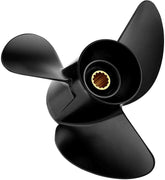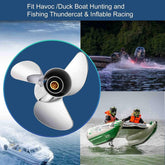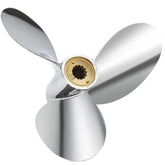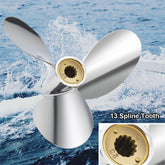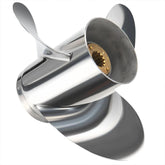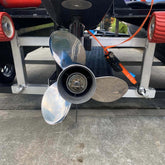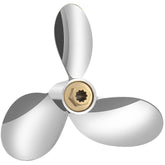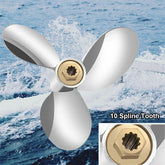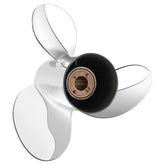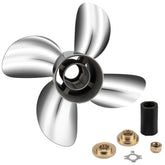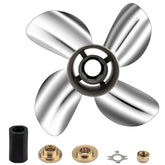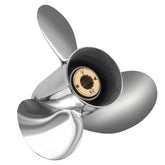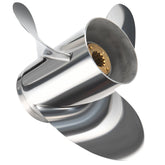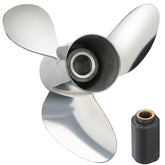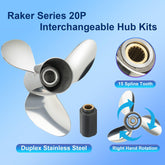How to Choose the Right Boat Propeller: Real Performance, Real Results
If you’ve ever owned a boat, you already know that your boat propeller plays a much bigger role than most people realize. It’s not just about making your boat move forward — it determines acceleration, top speed, handling, fuel efficiency, and even how stable your vessel feels at cruising speed. Choosing the wrong prop can turn a fun day on the water into frustration. The right one? Smooth performance, better control, and more time enjoying the sea instead of fighting it.
Many boat owners, especially first-time buyers, underestimate the science and precision behind propeller design. The truth is, every detail matters — from blade count and pitch to the hub design and material. Today, we’re going deep into how to pick the right boat propeller for your outboard motor, whether you’re running a Mercury, Yamaha, Suzuki, Honda, Volvo, or Tohatsu engine.
Before you hit “Add to Cart,” let’s make sure you’re getting it right.
Understanding What a Propeller Really Does
At its core, a propeller converts engine power into thrust — basically, it turns horsepower into forward motion. The prop’s blades act like rotating wings, creating pressure differences that push water backward and your boat forward.
But the way that power is transferred depends on the propeller’s size, pitch, rake, and number of blades. Even a minor change in diameter or pitch can drastically alter performance.
A Mercury outboard propeller designed for a 150 HP engine will perform very differently than one for a 90 HP Yamaha, even if they look similar at first glance. That’s why choosing a fit-for-brand propeller is crucial.
For example, if you’re running a Yamaha outboard, check out the collection of precisely engineered models at propeller for Yamaha.
Similarly, for Mercury engines, see the full range at propeller for MERCURY.
Key Propeller Factors That Affect Boat Performance
Diameter and Pitch
Diameter refers to how wide the circle is when the blades spin, and pitch describes how far the prop would move in one revolution through a solid medium.
A higher pitch prop gives you more top speed but slower acceleration, while a lower pitch prop improves holeshot and pulling power.
If you’re using a 4-stroke 90 HP Honda outboard, for instance, a prop with moderate pitch and balanced diameter often provides smoother acceleration. You can find options tailored for that setup at propeller for Honda.
Number of Blades
Traditionally, most boat propellers are 3-blade or 4-blade. A 3-blade propeller typically offers higher top-end speed and efficiency, while a 4-blade prop enhances grip and acceleration — perfect for water sports or heavier boats.
If you’re running a deep-V hull or heavy deck boat, a 4-blade aluminum propeller designed for Suzuki or Tohatsu engines can help maintain speed in rough conditions. See the propeller for Suzuki or propeller for Tohatsu for options.
Material: Aluminum vs Stainless Steel
This debate is as old as boating itself. Aluminum props are lightweight, affordable, and ideal for general boating use. Stainless steel props, on the other hand, are stronger, sharper, and hold their shape under load — perfect for high-speed or performance boats.
For instance, if you often run your Mercury 200 HP in saltwater or push higher RPMs, a stainless steel propeller will provide more consistent thrust and less flex. You can explore durable models from a leading boat propeller manufacturer.
The Role of Blade Design in Real-World Performance
Every blade shape and rake angle tells a story. A prop with more rake can lift the bow, which helps high-speed boats plane better. Meanwhile, cupping (small curls at the blade edges) improves grip and reduces slippage.
If you’re curious about how these propellers are built to such precision, check out this detailed look at How Boat Propellers Are Manufactured. It shows the step-by-step process — from casting and balancing to the final polish — behind every prop’s performance.
Matching Propellers to Boat Type and Usage
Different boats demand different prop characteristics:
-
Fishing Boats: Need fast planing and precise control. A 4-blade aluminum prop works well.
-
Pontoon Boats: Require higher thrust at lower speeds, so large-diameter, low-pitch props are ideal.
-
Speedboats: Perform best with stainless steel 3-blade designs optimized for top speed.
-
Heavy Workboats: Benefit from reinforced hubs and increased blade surface area for steady torque.
To match your propeller type to your specific engine, explore our full range at the Boat Propeller Online Store.
Understanding Fit: Propellers for Every Major Outboard Brand
If your boat runs a Mercury, Yamaha, Suzuki, Honda, Volvo, or Tohatsu outboard, you’ll find that each engine brand has its own gearcase design and spline configuration — meaning one propeller doesn’t fit all.
-
Propeller for MERCURY: Optimized for acceleration and durability.
-
Propeller for Yamaha: Designed for smoother midrange thrust.
-
Propeller for Volvo: Balanced for larger stern drives and inboard/outboards.
Choosing a fit propeller rather than an OEM-only option can offer better value while still maintaining performance parity.
Common Signs You Might Be Using the Wrong Propeller
If your boat shows any of these symptoms, you may need a propeller adjustment or replacement:
-
Over-revving without gaining speed
-
Poor fuel efficiency
-
Trouble getting on plane
-
Cavitation or excessive vibration
-
Blade damage or corrosion
You can easily find replacements, including YBS, Chopper, and Vengeance propeller designs, at VIF Marine’s Hot Selling Collection.
Real-World Example: Why Pitch Change Matters
Let’s say your 150 HP Mercury outboard runs a 13.25 x 17P prop, and you’re struggling to reach your target RPM.
Switching to a 15P can reduce your RPM and increase top speed — but at the expense of acceleration.
On the flip side, dropping to a 13P can get you on plane faster and improve towing power.
This fine-tuning process is part science, part art — and once you get it right, your boat will feel like a completely different machine.
Where to Buy Quality Boat Propellers Online
Finding the right prop doesn’t have to be complicated. You can browse, compare, and order directly from the Boat Propeller Online Store, where products are clearly categorized by engine type and horsepower.
If you want to learn more about the craftsmanship behind every product, visit VIF Marine, a trusted boat propeller manufacturer known for precision casting and quality assurance.
Final Thoughts
A great boat propeller isn’t just about horsepower — it’s about harmony. It’s how the engine, hull, and prop work together to deliver power, stability, and efficiency.
Whether you’re replacing a damaged prop, upgrading for better performance, or just learning how pitch and blade count affect your ride, investing in the right propeller is one of the best decisions you can make for your outboard.
So next time you hit the water, you’ll feel the difference — not just in speed, but in control, comfort, and pure enjoyment.


